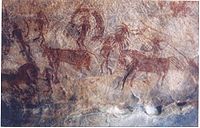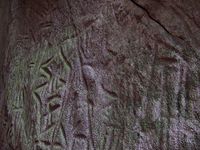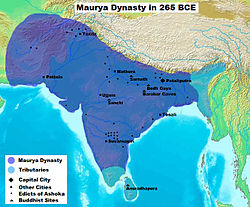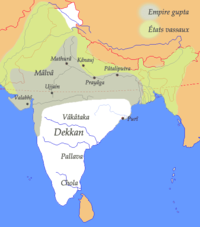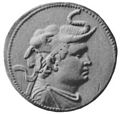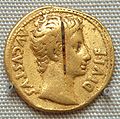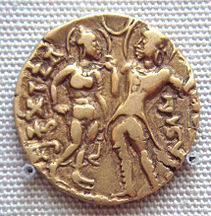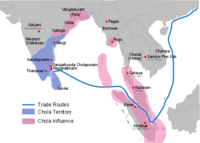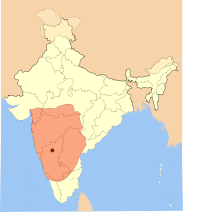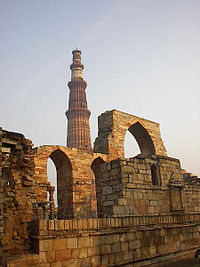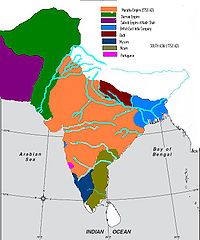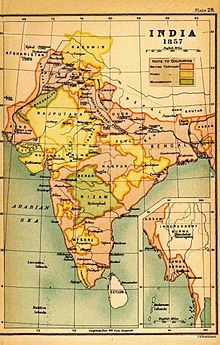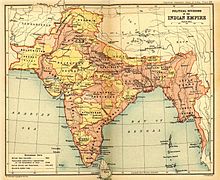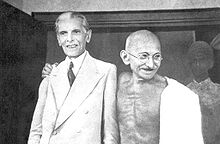- History of India
-
This article is about the history of the Indian subcontinent prior to the partition of India in 1947. For the modern Republic of India, see History of the Republic of India. For Pakistan and Bangladesh, see History of Pakistan and History of Bangladesh. For South India, see History of South India.
Part of a series on the History of India 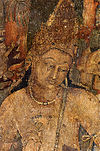
Chronology of Indian history Ancient India Prehistoric India and Vedic India
Religions, Society, MahajanapadasMauryan Period
Economy, Spread of Buddhism,
Chanakya, Satavahana EmpireThe Golden Age
Discoveries, Aryabhata,
Ramayana, MahabharataMedieval India The Classical Age
Gurjara-Pratihara
Pala Empire
Rashtrakuta Empire
Art, Philosophy, LiteratureIslam in India
Delhi Sultanate, Vijayanagara Empire,
Music, Guru NanakMughal India
Architecture,
Maratha ConfederacyModern India Company Rule
Zamindari system, Warren Hastings,
Mangal Pandey, 1857British Indian Empire
Hindu reforms, Bengal Renaissance,
Independence struggle, Mahatma GandhiThe history of India begins with evidence of human activity of Homo sapiens as long as 75,000 years ago, or with earlier hominids including Homo erectus from about 500,000 years ago.[1] The Indus Valley Civilization, which spread and flourished in the northwestern part of the Indian subcontinent from c. 3300 to 1300 BCE, was the first major civilization in India.[2] A sophisticated and technologically advanced urban culture developed in the Mature Harappan period, from 2600 to 1900 BCE.[3] This Bronze Age civilization collapsed before the end of the second millennium BCE and was followed by the Iron Age Vedic Civilization, which extended over much of the Indo-Gangetic plain and which witnessed the rise of major polities known as the Mahajanapadas. In one of these kingdoms, Magadha, Mahavira and Gautama Buddha were born in the 6th or 5th century BCE and propagated their śramanic philosophies.
Almost all of the subcontinent was conquered by the Maurya Empire during the 4th and 3rd centuries BCE. It subsequently became fragmented, with various parts ruled by numerous Middle kingdoms for the next 1,500 years. This is known as the classical period of Indian history, during which India has sometimes been estimated to have had the largest economy of the ancient and medieval world, controlling between one third and one fourth of the world's wealth up to the 18th century.
Much of northern and central India was once again united in the 4th century CE, and remained so for two centuries thereafter, under the Gupta Empire. This period, witnessing a Hindu religious and intellectual resurgence, is known among its admirers as the "Golden Age of India". During the same time, and for several centuries afterwards, southern India, under the rule of the Chalukyas, Cholas, Pallavas, and Pandyas, experienced its own golden age. During this period, aspects of Indian civilization, administration, culture, and religion (Hinduism and Buddhism) spread to much of Asia.
The southern state of Kerala had maritime business links with the Roman Empire from around 77 CE. Islam was introduced in Kerala through this route by Muslim traders. Muslim rule in the subcontinent began in 712 CE when the Arab general Muhammad bin Qasim conquered Sindh and Multan in southern Punjab in modern day Pakistan,[4] setting the stage for several successive invasions from Central Asia between the 10th and 15th centuries CE, leading to the formation of Muslim empires in the Indian subcontinent such as the Delhi Sultanate and the Mughal Empire.
Mughal rule came from Central Asia to cover most of the northern parts of the subcontinent. Mughal rulers introduced Central Asian art and architecture to India. In addition to the Mughals and various Rajput kingdoms, several independent Hindu states, such as the Vijayanagara Empire, the Maratha Empire,Eastern Ganga Empire and the Ahom Kingdom, flourished contemporaneously in southern, western,eastern and northeastern India respectively. The Mughal Empire suffered a gradual decline in the early 18th century, which provided opportunities for the Afghans, Balochis, Sikhs, and Marathas to exercise control over large areas in the northwest of the subcontinent until the British East India Company gained ascendancy over South Asia.[5]
Beginning in the mid-18th century and over the next century, large areas of India were gradually annexed by the British East India Company. Dissatisfaction with Company rule led to the Indian Rebellion of 1857, after which the British provinces of India were directly administered by the British Crown and witnessed a period of both rapid development of infrastructure and economic decline. During the first half of the 20th century, a nationwide struggle for independence was launched by the Indian National Congress and later joined by the Muslim League. The subcontinent gained independence from the United Kingdom in 1947, after the British provinces were partitioned into the dominions of India and Pakistan and the princely states all acceded to one of the new states.
Contents
Pre-Historic era
Stone Age
Main article: South Asian Stone AgeFurther information: Mehrgarh, Rock Shelters of Bhimbetka, and Edakkal CavesIsolated remains of Homo erectus in Hathnora in the Narmada Valley in central India indicate that India might have been inhabited since at least the Middle Pleistocene era, somewhere between 500,000 and 200,000 years ago.[6][7]
Tools crafted by proto-humans that have been dated back two million years have been discovered in the northwestern part of the subcontinent.[8][9] The ancient history of the region includes some of South Asia's oldest settlements[10] and some of its major civilizations.[11][12] The earliest archaeological site in the subcontinent is the palaeolithic hominid site in the Soan River valley.[13] Soanian sites are found in the Sivalik region across what are now India, Pakistan, and Nepal.[14]
The Mesolithic period in the Indian subcontinent was followed by the Neolithic period, when more extensive settlement of the subcontinent occurred after the end of the last Ice Age approximately 12,000 years ago. The first confirmed semipermanent settlements appeared 9,000 years ago in the Bhimbetka rock shelters in modern Madhya Pradesh, India.
Early Neolithic culture in South Asia is represented by the Mehrgarh findings (7000 BCE onwards) in present-day Balochistan, Pakistan.[15] Traces of a Neolithic culture have been alleged to be submerged in the Gulf of Khambat in India, radiocarbon dated to 7500 BCE.[16] However, the one dredged piece of wood in question was found in an area of strong ocean currents. Neolithic agriculture cultures sprang up in the Indus Valley region around 5000 BCE, in the lower Gangetic valley around 3000 BCE, and in later South India, spreading southwards and also northwards into Malwa around 1800 BCE. The first urban civilization of the region began with the Indus Valley Civilization.[17]
Bronze Age
Main article: Indus Valley CivilizationSee also: Economic history of India and Timeline of the economy of India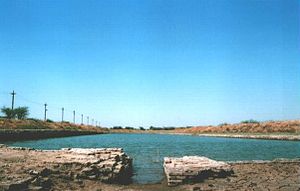 The docks of ancient Lothal as they appear today.
The docks of ancient Lothal as they appear today.
 "Priest King" of Indus Valley Civilization
"Priest King" of Indus Valley Civilization
The Bronze Age in the Indian subcontinent began around 3300 BCE with the early Indus Valley Civilization. It was centered on the Indus River and its tributaries which extended into the Ghaggar-Hakra River valley,[11] the Ganges-Yamuna Doab,[18] Gujarat,[19] and southeastern Afghanistan.[20]
The civilization is primarily located in modern-day India (Gujarat, Haryana, Punjab and Rajasthan provinces) and Pakistan (Sindh, Punjab, and Balochistan provinces). Historically part of Ancient India, it is one of the world's earliest urban civilizations, along with Mesopotamia and Ancient Egypt.[21] Inhabitants of the ancient Indus river valley, the Harappans, developed new techniques in metallurgy and handicraft (carneol products, seal carving), and produced copper, bronze, lead, and tin.
The Mature Indus civilization flourished from about 2600 to 1900 BCE, marking the beginning of the urban civilization on the subcontinent. The civilization included urban centers such as Dholavira, Kalibangan, Rupar, Rakhigarhi, and Lothal in modern-day India, and Harappa, Ganeriwala, and Mohenjo-daro in modern-day Pakistan. The civilization is noted for its cities built of brick, roadside drainage system, and multistoried houses.
Early historic period
Vedic period
Main article: Vedic CivilizationSee also: Vedas and Indo-AryansThe Vedic period is characterized by Indo-Aryan culture associated with the texts of Vedas, sacred to Hindus, which were orally composed in Vedic Sanskrit. The Vedas are some of the oldest extant texts in India[22] and next to some writings in Egypt and Mesopotamia are the oldest in the world. The Vedic period lasted from about 1500 to 500 BCE,[23] laying the foundations of Hinduism and other cultural aspects of early Indian society. The Aryans established Vedic civilization all over north India, particularly in the Gangetic Plain. This period succeeded the prehistoric Late Harappan, during which immigrations of Indo-Aryan-speaking tribes overlaid the existing civilizations of local people whom they called Dasyus. The Aryans, originally came from the Caspian Sea area of Asia.[24] Settling first in Bactria and then in the Hindu-Kush area of India, before settling in the Ganges and Yamuna River valleys.[25]
Many scholars throughout history have maintained that the Aryans subjugated the "backward aboriginies" that had previously lived in northern India.[26] However, discoveries of advanced civilizations in the Indus River valley, caused many scholars to change their theories in this regard. The Aryans may have received as much from the neighboring cultures of northern India as they contributed. Indeed when the Aryans moved into India, they were semi-nomadic pastoralists,[27] their clothing was simple,[28] they had no regular legal institutions[29] and their religion was a very basic form of animism. The basis of the Aryan economy had always been centered around cattle raising.[30] During this period of time, the cow began to be venerated in Aryan society. Thus, the origins of the later Hindu belief in India that cows are sacred may have started during this time.[31]
 The swastika is a major element of Hindu heiiconography.
The swastika is a major element of Hindu heiiconography.
Early Vedic society consisted of largely pastoral groups, with late Harappan urbanization having been abandoned.[32] After the time of the Rigveda, Aryan society became increasingly agricultural and was socially organized around the four varnas, or social classes. In addition to the Vedas, the principal texts of Hinduism, the core themes of the Sanskrit epics Ramayana and Mahabharata are said to have their ultimate origins during this period.[33] The Mahabharata remains, today, the longest single poem in the world.[34] The events described in the shorter, Ramayana are from a later period of history than the events of the Mahabharata.[35] The early Indo-Aryan presence probably corresponds, in part, to the Ochre Coloured Pottery culture in archaeological contexts.[36]
The Kuru kingdom[37] corresponds to the Black and Red Ware and Painted Grey Ware cultures and to the beginning of the Iron Age in northwestern India, around 1000 BCE, as well as with the composition of the Atharvaveda, the first Indian text to mention iron, as śyāma ayas, literally "black metal." The Painted Grey Ware culture spanned much of northern India from about 1100 to 600 BCE.[36] The Vedic Period also established republics such as Vaishali, which existed as early as the 6th century BCE and persisted in some areas until the 4th century CE. The later part of this period corresponds with an increasing movement away from the previous tribal system towards the establishment of kingdoms, called mahajanapadas.
Mahajanapadas
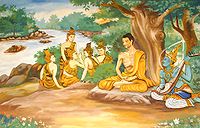 Gautama Buddha undertaking extreme ascetic practices before his enlightenment on the bank of river Falgu in Bodh Gaya, Bihar.
Gautama Buddha undertaking extreme ascetic practices before his enlightenment on the bank of river Falgu in Bodh Gaya, Bihar.
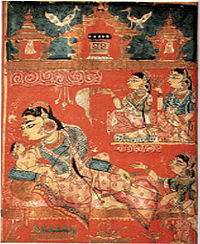 Detail of a leaf with, The Birth of Mahavira (the 24th Tirthankara of Jainism), from the Kalpa Sutra, c.1375-1400.
Detail of a leaf with, The Birth of Mahavira (the 24th Tirthankara of Jainism), from the Kalpa Sutra, c.1375-1400.
 The Mahajanapadas were the sixteen most powerful kingdoms and republics of the era, located mainly across the fertile Indo-Gangetic plains, however there were a number of smaller kingdoms stretching the length and breadth of Ancient India.
The Mahajanapadas were the sixteen most powerful kingdoms and republics of the era, located mainly across the fertile Indo-Gangetic plains, however there were a number of smaller kingdoms stretching the length and breadth of Ancient India.
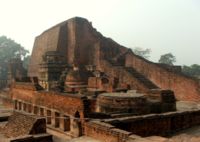 Nalanda is considered one of the first great universities in recorded history. It was the center of Buddhist learning and research in the world from 450 to 1193 CE.
Nalanda is considered one of the first great universities in recorded history. It was the center of Buddhist learning and research in the world from 450 to 1193 CE. Main articles: Mahajanapadas and Magadha EmpireMain articles: History of Hinduism, History of Buddhism, and History of JainismFurther information: Upanishads, Indian Religions, Indian philosophy, and Ancient universities of India
Main articles: Mahajanapadas and Magadha EmpireMain articles: History of Hinduism, History of Buddhism, and History of JainismFurther information: Upanishads, Indian Religions, Indian philosophy, and Ancient universities of IndiaIn the later Vedic Age, a number of small kingdoms or city states had covered the subcontinent, many mentioned in Vedic, early Buddhist and Jaina literature as far back as 1000 BCE. By 500 BCE, sixteen monarchies and "republics" known as the Mahajanapadas — Kasi, Kosala, Anga, Magadha, Vajji (or Vriji), Malla, Chedi, Vatsa (or Vamsa), Kuru, Panchala, Matsya (or Machcha), Surasena, Assaka, Avanti, Gandhara, and Kamboja — stretched across the Indo-Gangetic Plain from modern-day Afghanistan to Bengal and Maharastra. This period saw the second major rise of urbanism in India after the Indus Valley Civilization.
Many smaller clans mentioned within early literature seem to have been present across the rest of the subcontinent. Some of these kings were hereditary; other states elected their rulers. The educated speech at that time was Sanskrit, while the languages of the general population of northern India are referred to as Prakrits. Many of the sixteen kingdoms had coalesced to four major ones by 500/400 BCE, by the time of Gautama Buddha. These four were Vatsa, Avanti, Kosala, and Magadha.[38]
Hindu rituals at that time were complicated and conducted by the priestly class. It is thought that the Upanishads, late Vedic texts dealing mainly with philosophy, were composed in the later Vedic Age and early in this period of the Mahajanapadas (from about 600 to 400 BCE). The Upanishads had a substantial effect on Indian philosophy and were contemporary with the development of Buddhism and Jainism, indicating a golden age of thought in this period.
According to Buddhism, Gautama Buddha attained the state of "enlightenment" and became known as Buddha "Enlightened" c. 537 BCE. Around the same time, Mahavira (the 24th Tirthankara in Jainism) propagated a similar theology that was to later become Jainism.[39] However, Jain orthodoxy believes the teachings of the Tirthankaras predates all known time and scholars believe Parshva, accorded status as the 23rd Tirthankara, was a historical figure. The Vedas are believed to have documented a few Tirthankaras and an ascetic order similar to the shramana movement.[40]
The Buddha's teachings and Jainism had doctrines inclined toward asceticism, and they were preached in Prakrit, which helped them gain acceptance amongst the masses. They have profoundly influenced practices that Hinduism and Indian spiritual orders are associated with, including vegetarianism, prohibition of animal slaughter and ahimsa (non-violence). While the geographic impact of Jainism was limited to India, Buddhist nuns and monks eventually spread the teachings of Buddha to Central Asia, East Asia, Tibet, Sri Lanka and Southeast Asia.
Persian and Greek conquests
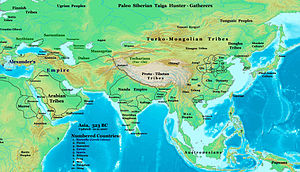 Asia in 323 BCE, the Nanda Empire and Gangaridai Empire in relation to Alexander's Empire and neighbors.
Asia in 323 BCE, the Nanda Empire and Gangaridai Empire in relation to Alexander's Empire and neighbors.
In 530 BCE Cyrus, King of the Persian Achaemenid Empire crossed the Hindu-Kush mountains to seek tribute from the tribes of Kamboja, Gandhara and the trans-India region.[41] By 520 BCE, during the reign of Darius I of Persia, much of the northwestern subcontinent (present-day eastern Afghanistan and Pakistan) came under the rule of the Persian Achaemenid Empire. The area remained under Persian control for two centuries.[42] During this time India supplied mercenaries to the Persian army then fighting in Greece.[41] Under Persian rule the famous city of Takshashila became a center where both Vedic and Iranian learning were mingled.[43] The impact of Persian ideas was felt in many areas of Indian life. Persian coinage and rock inscriptions were copied by India. However, Persian ascendency in northern India ended with Alexander the Great's conquest of Persia in 327 BCE.[44]
By 326 BCE, Alexander the Great had conquered Asia Minor and the Achaemenid Empire and had reached the northwest frontiers of the Indian subcontinent. There he defeated King Porus in the Battle of the Hydaspes (near modern-day Jhelum, Pakistan) and conquered much of the Punjab.[45] Alexander's march east put him in confrontation with the Nanda Empire of Magadha and the Gangaridai Empire of Bengal. His army, exhausted and frightened by the prospect of facing larger Indian armies at the Ganges River, mutinied at the Hyphasis (modern Beas River) and refused to march further East. Alexander, after the meeting with his officer, Coenus, was convinced that it was better to return.
The Persian and Greek invasions had important repercussions on Indian civilization. The political systems of the Persians were to influence future forms of governance on the subcontinent, including the administration of the Mauryan dynasty. In addition, the region of Gandhara, or present-day eastern Afghanistan and northwest Pakistan, became a melting pot of Indian, Persian, Central Asian, and Greek cultures and gave rise to a hybrid culture, Greco-Buddhism, which lasted until the 5th century CE and influenced the artistic development of Mahayana Buddhism.
Maurya Empire
Main article: Maurya Empire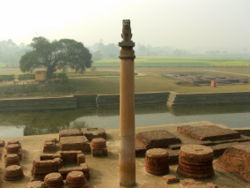 Ashokan pillar at Vaishali, 3rd century BCE.
Ashokan pillar at Vaishali, 3rd century BCE.
The Maurya Empire (322–185 BCE), ruled by the Mauryan dynasty, was a geographically extensive and powerful political and military empire in ancient India. The empire was established by Chandragupta Maurya in Magadha what is now Bihar.[46] The empire flourished under the reign of Ashoka the Great.[47] At its greatest extent, it stretched to the north to the natural boundaries of the Himalayas and to the east into what is now Assam. To the west, it reached beyond modern Pakistan, annexing Balochistan and much of what is now Afghanistan, including the modern Herat and Kandahar provinces. The empire was expanded into India's central and southern regions by the emperors Chandragupta and Bindusara, but it excluded extensive unexplored tribal and forested regions near Kalinga which were subsequently taken by Ashoka. Like every state, the Maurya Empire needed to have a unified administrative apparatus. Ashoka ruled the Maurya Empire for 37 years from 268 BCE until he died in 232 BCE.[48] During that time, Ashoka pursued an active foreign policy aimed at setting up a unified state.[49] However, Ashoka became involved in a war with the state of Kalinga which is located on the western shore of the Bay of Bengal.[50] This war forced Ashoka to abandon his attempt at a foreign policy which would unify the Maurya Empire.[51]
Slavery had begun in India during the Vedic era. However, during the Mauryan Empire slavery developed much more rapidly.[52] The Mauryan Empire was based on a modern and efficient economy and society. However, the sale of merchandise was closely regulated by the government.[53] Although there was no banking in the Mauryan society, usury was customary with loans made at the recognized interest rate of 15% per annum.
Ashoka's reign propagated Buddhism. In this regard Ashoka established many Buddhist monuments. Indeed, Ashoka put a strain on the economy and the government by his strong support of Buddhism. towards the end of his reign he "bled the state coffers white with his generous gifts to promote the promulation of Buddha's teaching.[54] As might be expected, this policy caused considerable opposition within the government. This opposition rallied around Sampadi, Ashoka's grandson and heir to the throne.[55] Religious opposition to Ashoka also arose among the orthodox Brahmanists and the adherents of Jainism--a religion based on non-violence toward all living beings.[56]
Chandragupta's minister Chanakya wrote the Arthashastra, one of the greatest treatises on economics, politics, foreign affairs, administration, military arts, war, and religion produced in Asia. Archaeologically, the period of Mauryan rule in South Asia falls into the era of Northern Black Polished Ware (NBPW). The Arthashastra and the Edicts of Ashoka are primary written records of the Mauryan times. The Lion Capital of Asoka at Sarnath, is the national emblem of India.
Early Middle Kingdoms — The Golden Age
Main article: Middle Kingdoms of India Ancient India during the rise of Sunga Empire and Satavahana Empire.
Ancient India during the rise of Sunga Empire and Satavahana Empire.
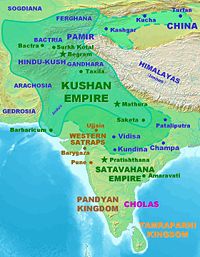 Kushan Empire and Western Satraps of Ancient India in the north along with Pandyans and Early Cholas in southern India.
Kushan Empire and Western Satraps of Ancient India in the north along with Pandyans and Early Cholas in southern India.
The middle period was a time of notable cultural development. The Satavahana dynasty, also known as the Andhras, ruled in southern and central India after around 230 BCE. Satakarni, the sixth ruler of the Satvahana dynasty, defeated the Sunga Empire of north India. Afterwards, Kharavela, the warrior king of Kalinga,[57] ruled a vast empire and was responsible for the propagation of Jainism in the Indian subcontinent.[57] The Kharavelan Jain empire included a formidable maritime empire with trading routes linking it to Sri Lanka, Burma, Thailand, Vietnam, Cambodia, Borneo, Bali, Sumatra, and Java. Colonists from Kalinga settled in Sri Lanka, Burma, as well as the Maldives and the Malay Archipelago. The Kuninda Kingdom was a small Himalayan state that survived from around the 2nd century BCE to roughly the 3rd century CE. The Kushanas migrated from Central Asia into northwestern India in the middle of the 1st century CE and founded an empire that eventually stretched from Tajikistan to the middle Ganges. The Western Satraps (35-405 CE) were Saka rulers of the western and central part of India. They were the successors of the Indo-Scythians and contemporaries of the Kushans who ruled the northern part of the Indian subcontinent and the Satavahana (Andhra) who ruled in central and southern India.
Different dynasties such as the Pandyans, Cholas, Cheras, Kadambas, Western Gangas, Pallavas, and Chalukyas, dominated the southern part of the Indian peninsula at different periods of time. Several southern kingdoms formed overseas empires that stretched into Southeast Asia. The kingdoms warred with each other and the Deccan states for domination of the south. The Kalabras, a Buddhist dynasty, briefly interrupted the usual domination of the Cholas, Cheras, and Pandyas in the south.
Northwestern hybrid cultures
The northwestern hybrid cultures of the subcontinent included the Indo-Greeks, the Indo-Scythians, the Indo-Parthians, and the Indo-Sassinids. The first of these, the Indo-Greek Kingdom, was founded when the Greco-Bactrian king Demetrius invaded the region in 180 BCE, extending his rule over various parts of present-day Afghanistan and Pakistan. Lasting for almost two centuries, the kingdom was ruled by a succession of more than 30 Greek kings, who were often in conflict with each other. The Indo-Scythians were a branch of the Indo-European Sakas (Scythians) who migrated from southern Siberia, first into Bactria, subsequently into Sogdiana, Kashmir, Arachosia, and Gandhara, and finally into India. Their kingdom lasted from the middle of the 2nd century BCE to the 1st century BCE. Yet another kingdom, the Indo-Parthians (also known as the Pahlavas), came to control most of present-day Afghanistan and northern Pakistan, after fighting many local rulers such as the Kushan ruler Kujula Kadphises, in the Gandhara region. The Sassanid empire of Persia, who was contemporaneous with the Gupta Empire, expanded into the region of present-day Balochistan in Pakistan, where the mingling of Indian culture and the culture of Iran gave birth to a hybrid culture under the Indo-Sassanids.
Kushan Empire
Main article: Kushan EmpireThe Kushan Empire expanded out of what is now Afghanistan into the northwest of the subcontinent under the leadership of their first emperor, Kujula Kadphises, about the middle of the 1st century CE. By the time of his grandson, Kanishka, (whose era is thought to have begun c. 127 CE), they had conquered most of northern India, at least as far as Saketa and Pataliputra, in the middle Ganges Valley, and probably as far as the Bay of Bengal.[58] They played an important role in the establishment of Buddhism in India and its spread to Central Asia and China. By the 3rd century, their empire in India was disintegrating; their last known great emperor being Vasudeva I (c. 190-225 CE).
Roman trade with India
Main article: Roman trade with IndiaRoman trade with India started around 1 CE, during the reign of Augustus and following his conquest of Egypt, which had been India's biggest trade partner in the West.
The trade started by Eudoxus of Cyzicus in 130 BCE kept increasing, and according to Strabo (II.5.12.[59]), by the time of Augustus, up to 120 ships set sail every year from Myos Hormos on the Red Sea to India. So much gold was used for this trade, and apparently recycled by the Kushans for their own coinage, that Pliny the Elder (NH VI.101) complained about the drain of specie to India:
"India, China and the Arabian peninsula take one hundred million sesterces from our empire per annum at a conservative estimate: that is what our luxuries and women cost us. For what percentage of these imports is intended for sacrifices to the gods or the spirits of the dead?"—Pliny, Historia Naturae 12.41.84.[60]The maritime (but not the overland) trade routes, harbours, and trade items are described in detail in the 1st century CE Periplus of the Erythraean Sea.
Gupta rule
 Gupta Empire (240 to 550 AD)
Gupta Empire (240 to 550 AD) Main article: Gupta EmpireFurther information: Meghadūta, Abhijñānaśākuntala, Kumārasambhava, Panchatantra, Aryabhatiya, Indian numerals, and Kama Sutra
Main article: Gupta EmpireFurther information: Meghadūta, Abhijñānaśākuntala, Kumārasambhava, Panchatantra, Aryabhatiya, Indian numerals, and Kama SutraThe Classical Age refers to the period when much of the Indian subcontinent was reunited under the Gupta Empire (c. 320–550 CE).[61][62] This period has been called the Golden Age of India[63] and was marked by extensive achievements in science, technology, engineering, art, dialectic, literature, logic, mathematics, astronomy, religion, and philosophy that crystallized the elements of what is generally known as Hindu culture.[64] The decimal numeral system, including the concept of zero, was invented in India during this period.[65] The peace and prosperity created under leadership of Guptas enabled the pursuit of scientific and artistic endeavors in India.[66]
The high points of this cultural creativity are magnificent architecture, sculpture, and painting.[67] The Gupta period produced scholars such as Kalidasa, Aryabhata, Varahamihira, Vishnu Sharma, and Vatsyayana who made great advancements in many academic fields.[68] Science and political administration reached new heights during the Gupta era. Strong trade ties also made the region an important cultural center and established it as a base that would influence nearby kingdoms and regions in Burma, Sri Lanka, the Malay Archipelago, and Indochina.
The Gupta period marked a watershed of Indian culture: the Guptas performed Vedic sacrifices to legitimize their rule, but they also patronized Buddhism, which continued to provide an alternative to Brahmanical orthodoxy. The military exploits of the first three rulers—Chandragupta I (c. 319–335), Samudragupta (c. 335–376), and Chandragupta II (c. 376–415) —brought much of India under their leadership.[69] They successfully resisted the northwestern kingdoms until the arrival of the Hunas, who established themselves in Afghanistan by the first half of the 5th century, with their capital at Bamiyan.[70] However, much of the Deccan and southern India were largely unaffected by these events in the north.[71][72]
Late Middle Kingdoms — The Classical Age
Main articles: Middle Kingdoms of India , Badami Chalukyas , Rashtrakuta , Eastern Ganga dynasty, Western Chalukyas , and Vijayanagara Empire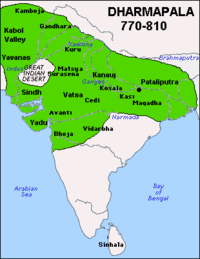
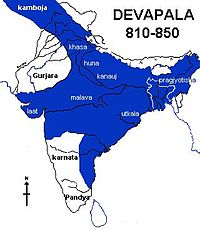 Pala Empire under DharmapalaPala Empire under Devapala
Pala Empire under DharmapalaPala Empire under DevapalaThe "Classical Age" in India began with the Gupta Empire and the resurgence of the north during Harsha's conquests around the 7th century CE, and ended with the fall of the Vijayanagara Empire in the south in the 13th century, due to pressure from the invaders to the north. This period produced some of India's finest art, considered the epitome of classical development, and the development of the main spiritual and philosophical systems which continued to be in Hinduism, Buddhism and Jainism. King Harsha of Kannauj succeeded in reuniting northern India during his reign in the 7th century, after the collapse of the Gupta dynasty. His kingdom collapsed after his death.
From the 7th to the 9th century, three dynasties contested for control of northern India: the Gurjara Pratiharas of Malwa,the Eastern Ganga dynasty of Orissa, the Palas of Bengal, and the Rashtrakutas of the Deccan. The Sena dynasty would later assume control of the Pala Empire, and the Gurjara Pratiharas fragmented into various states. These were the first of the Rajput states, a series of kingdoms which managed to survive in some form for almost a millennium, until Indian independence from the British. The first recorded Rajput kingdoms emerged in Rajasthan in the 6th century, and small Rajput dynasties later ruled much of northern India. One Gurjar[73][74] Rajput of the Chauhan clan, Prithvi Raj Chauhan, was known for bloody conflicts against the advancing Islamic sultanates. The Shahi dynasty ruled portions of eastern Afghanistan, northern Pakistan, and Kashmir from the mid-7th century to the early 11th century.
The Chalukya dynasty ruled parts of southern and central India from Badami in Karnataka between 550 and 750, and then again from Kalyani between 970 and 1190. The Pallavas of Kanchipuram were their contemporaries further to the south. With the decline of the Chalukya empire, their feudatories, the Hoysalas of Halebidu, Kakatiyas of Warangal, Seuna Yadavas of Devagiri, and a southern branch of the Kalachuri, divided the vast Chalukya empire amongst themselves around the middle of 12th century.
The Chola Empire at its peak covered much of the Indian subcontinent and Southeast Asia. Rajaraja Chola I conquered all of peninsular south India and parts of Sri Lanka. Rajendra Chola I's navies went even further, occupying coasts from Burma (now Myanmar) to Vietnam,[75] the Andaman and Nicobar Islands, the Lakshadweep (Laccadive) islands, Sumatra, and the Malay Peninsula in Southeast Asia and the Pegu islands. Later during the middle period, the Pandyan Empire emerged in Tamil Nadu, as well as the Chera Empire in Kerala. By 1343, all these dynasties had ceased to exist, giving rise to the Vijayanagar empire.
The ports of south India were engaged in the Indian Ocean trade, chiefly involving spices, with the Roman Empire to the west and Southeast Asia to the east.[76][77] Literature in local vernaculars and spectacular architecture flourished until about the beginning of the 14th century, when southern expeditions of the sultan of Delhi took their toll on these kingdoms. The Hindu Vijayanagar dynasty came into conflict with the Islamic Bahmani Sultanate, and the clashing of the two systems caused a mingling of the indigenous and foreign cultures that left lasting cultural influences on each other. The Vijaynagar Empire eventually declined due to pressure from the first Delhi sultanates that had managed to establish themselves in the north around the city of Delhi by that time.
The Islamic Sultanates
Main article: Islamic Empires in IndiaSee also: Bahmani Sultanate and Deccan Sultanates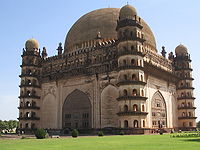 Gol Gumbaz at Bijapur, has the second largest pre-modern dome in the world after the Byzantine Hagia Sophia.
Gol Gumbaz at Bijapur, has the second largest pre-modern dome in the world after the Byzantine Hagia Sophia.
After conquering Persia, Arab Islamic Caliphate incorporated parts of what is now Pakistan around 720 CE. The Muslim rulers were keen to invade India,[78] which was a rich region,[79] with a flourishing international trade and the only known diamond mines in the world. In 712 CE an Arab Muslim general called Muhammad bin Qasim conquered most of the Indus region in modern day Pakistan, for the Umayyad empire, to be made the "As-Sindh" province with its capital at Al-Mansurah, 72 km (45 mi) north of modern Hyderabad in Sindh, Pakistan. After several wars including the Battle of Rajasthan, where the Hindu Rajput clans defeated the Umayyad Arabs, their expansion was checked and contained to Sindh in Pakistan[citation needed], many short-lived Islamic kingdoms (sultanates) under foreign rulers were established across the north western subcontinent over a period of a few centuries. Additionally, Muslim trading communities had flourished throughout coastal south India, particularly in Kerala, where Muslim traders arrived in small numbers, mainly from the Arabian peninsula. This had marked the introduction of a third Abrahamic Middle Eastern religion, following Judaism and Christianity, often in puritanical form. Later, the Bahmani Sultanate and Deccan sultanates founded by Turkic rulers, flourished in the south.
Delhi Sultanate
Qutub Minar is the world's tallest brick minaret, commenced by Qutb-ud-din Aybak of the Slave dynasty. Main article: Delhi Sultanate
Main article: Delhi SultanateIn the 12th and 13th centuries, Turks and Afghans invaded parts of northern India and established the Delhi Sultanate in the former Rajput holdings.[80] The subsequent Slave dynasty of Delhi managed to conquer large areas of northern India, approximately equal in extent to the ancient Gupta Empire, while the Khilji dynasty was also able to conquer most of central India, but were ultimately unsuccessful in conquering and uniting the subcontinent. The Sultanate ushered in a period of Indian cultural renaissance. The resulting "Indo-Muslim" fusion of cultures left lasting syncretic monuments in architecture, music, literature, religion, and clothing. It is surmised that the language of Urdu (literally meaning "horde" or "camp" in various Turkic dialects) was born during the Delhi Sultanate period as a result of the intermingling of the local speakers of Sanskritic Prakrits with immigrants speaking Persian, Turkic, and Arabic under the Muslim rulers. The Delhi Sultanate is the only Indo-Islamic empire to have enthroned one of the few female rulers in India, Razia Sultana (1236–1240).
A Turco-Mongol conqueror in Central Asia, Timur (Tamerlane), attacked the reigning Sultan Nasir-u Din Mehmud of the Tughlaq Dynasty in the north Indian city of Delhi.[81] The Sultan's army was defeated on December 17, 1398. Timur entered Delhi and the city was sacked, destroyed, and left in ruins, after Timur's army had killed and plundered for three days and nights. He ordered the whole city to be sacked except for the sayyids, scholars, and the other Muslims,; 100,000 war prisoners, mostly Hindus, were put to death in one day.[82]
The Mughal era
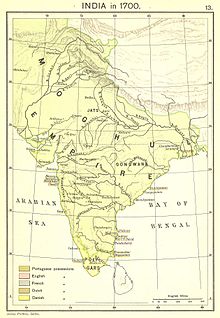 Extent of the Mughal Empire in 1700.
Extent of the Mughal Empire in 1700.
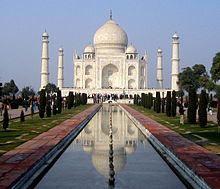 Taj Mahal, built by the Mughals
Taj Mahal, built by the Mughals Main article: Mughal Empire
Main article: Mughal EmpireIn 1526, Babur, a Timurid descendant of Timur and Genghis Khan from Fergana Valley(modern day Uzbekistan), swept across the Khyber Pass and established the Mughal Empire, covering modern day Afghanistan, Pakistan, India and Bangladesh.[83] However, his son Humayun was defeated by the Afghan warrior Sher Shah Suri in the year 1540, and Humayun was forced to retreat to Kabul. After Sher Shah's death, his son Islam Shah Suri and the Hindu king Samrat Hem Chandra Vikramaditya, who had won 22 battles from Punjab to Bengal and had established a secular Hindu Raj, ruled North India from Delhi till 1556, when Akbar's forces defeated and killed Hemu in the Second Battle of Panipat on 6 November 1556.
The Mughal dynasty ruled most of the Indian subcontinent by 1600; it went into a slow decline after 1707 and was finally defeated during the Indian Rebellion of 1857, also called the 1857 War of Independence. This period marked vast social change in the subcontinent as the Hindu majority were ruled over by the Mughal emperors, most of whom showed religious tolerance, liberally patronising Hindu culture. The famous emperor Akbar, who was the grandson of Babar, tried to establish a good relationship with the Hindus. However, later emperors such as Aurangazeb tried to establish complete Muslim dominance, and as a result several historical temples were destroyed during this period and taxes imposed on non-Muslims. During the decline of the Mughal Empire, several smaller states rose to fill the power vacuum and themselves were contributing factors to the decline. In 1739, Nader Shah, emperor of Iran, defeated the Mughal army at the huge Battle of Karnal. After this victory, Nader captured and sacked Delhi, carrying away many treasures, including the Peacock Throne.[84]
The Mughals were perhaps the richest single dynasty to have ever existed. During the Mughal era, the dominant political forces consisted of the Mughal Empire and its tributaries and, later on, the rising successor states - including the Maratha confederacy - which fought an increasingly weak Mughal dynasty. The Mughals, while often employing brutal tactics to subjugate their empire, had a policy of integration with Indian culture, which is what made them successful where the short-lived Sultanates of Delhi had failed. Akbar the Great was particularly famed for this. Akbar declared "Amari" or non-killing of animals in the holy days of Jainism. He rolled back the jizya tax for non-Muslims. The Mughal emperors married local royalty, allied themselves with local maharajas, and attempted to fuse their Turko-Persian culture with ancient Indian styles, creating a unique Indo-Saracenic architecture. It was the erosion of this tradition coupled with increased brutality and centralization that played a large part in the dynasty's downfall after Aurangzeb, who unlike previous emperors, imposed relatively non-pluralistic policies on the general population, which often inflamed the majority Hindu population.
Post-Mughal period
Main articles: Maratha Empire, Kingdom of Mysore, Hyderabad State, Sikh Empire, Rajputs, and Durrani EmpireSee also: History of Sikhism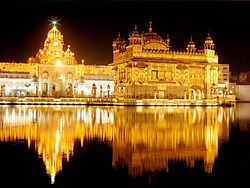 Harmandir Sahib or The Golden Temple is culturally the most significant place of worship for the Sikhs.
Harmandir Sahib or The Golden Temple is culturally the most significant place of worship for the Sikhs.
The post-Mughal era was dominated by the rise of the Maratha suzerainty as other small regional states (mostly late Mughal tributary states) emerged, and also by the increasing activities of European powers (see colonial era below). The Maratha kingdom or confederacy was founded and consolidated by Shivaji. By the 18th century, it had transformed itself into the Maratha Empire under the rule of the peshwas (prime ministers). By 1760, the domain of the Marathas stretched across practically the entire subcontinent. This expansion was brought to an end by the defeat of the Marathas by an Afghan army led by Ahmad Shah Durrani at the Third Battle of Panipat (1761). The last peshwa, Baji Rao II, was defeated by the British in the Third Anglo-Maratha War.
The Kingdom of Mysore in southern India was founded around 1400 CE by the Wodeyar dynasty. The rule of the Wodeyars was interrupted by Hyder Ali and his son Tipu Sultan. Under their rule, Mysore fought a series of wars sometimes against the combined forces of the British and Marathas, but mostly against the British, with Mysore receiving some aid or promise of aid from the French.
Hyderabad was founded by the Qutb Shahi dynasty of Golconda in 1591. Following a brief Mughal rule, Asif Jah, a Mughal official, seized control of Hyderabad and declared himself Nizam-al-Mulk of Hyderabad in 1724. It was ruled by a hereditary Nizam from 1724 until 1948. Both Mysore and Hyderabad became princely states in British India.
The Punjabi kingdom, ruled by members of the Sikh religion, was a political entity that governed the region of modern-day Punjab. This was among the last areas of the subcontinent to be conquered by the British. The first and second Anglo-Sikh war marked the downfall of the Sikh Empire.
Around the 18th century, the modern state of Nepal was formed by Gurkha rulers.
Colonial era
Main article: Colonial IndiaIn 1498, Vasco da Gama successfully discovered a new sea route from Europe to India, which paved the way for direct Indo-European commerce.[85] The Portuguese soon set up trading posts in Goa, Daman, Diu and Bombay. The next to arrive were the Dutch, the British—who set up a trading post in the west coast port of Surat[86] in 1619—and the French. The internal conflicts among Indian kingdoms gave opportunities to the European traders to gradually establish political influence and appropriate lands. Although these continental European powers controlled various coastal regions of southern and eastern India during the ensuing century, they eventually lost all their territories in India to the British islanders, with the exception of the French outposts of Pondicherry and Chandernagore, the Dutch port of Travancore, and the Portuguese colonies of Goa, Daman and Diu.
Company rule in India
Main articles: East India Company and Company rule in IndiaIn 1617 the British East India Company was given permission by Mughal Emperor Jahangir to trade in India.[87] Gradually their increasing influence led the de-jure Mughal emperor Farrukh Siyar to grant them dastaks or permits for duty free trade in Bengal in 1717.[88] The Nawab of Bengal Siraj Ud Daulah, the de facto ruler of the Bengal province, opposed British attempts to use these permits.
The First Carnatic War extended from 1746 until 1748 and was the result of colonial competition between France and Britain, two of the countries involved in the War of Austrian Succession. Following the capture of a few French ships by the British fleet in India, French troops attacked and captured the British city of Madras located on the east coast of India on September 21, 1746. Among the prisoners captured at Madras was Robert Clive himself. The war was eventually ended by the Treaty of Aix-la-Chapelle which ended the War of Austrian Succession in 1748.
In 1749, the Second Carnatic War broke out as the result of a war between a son, Nasir Jung, and a grandson, Muzaffer Jung, of the deceased Nizam-ul-Mulk of Hyderabad to take over Nizam's thone in Hyderabad. The French supported Muzaffer Jung in this civil war. Consequently, the British supported Nasir Jung in this conflict.
Meanwhile, however, the conflict in Hyderabad provided Chanda Sahib with an opportunity to take power as the new Nawab of the territory of Arcot. In this conflict, the French supported Chandra Sahib in his attempt to become the new Nawab of Arcot. The British supported the son of the deposed incumbent Nawab, Anwaruddin Muhammad Khan, against Chanda Sahib. In 1751, Robert Clive led a British armed force and captured Arcot to reinstate the incumbent Nawab. The Second Carnatic War finally came to an end in 1754 with the Treaty of Pondicherry.
In 1756, the Seven Years War broke out between the great powers of the world, i.e. Britain and Prussia on one side and France, Austria and Russia on the other.[89] The Seven Years War was really a "world war", with theaters of operations in Europe, the Caribbean, North America and India. Indeed, Winston Churchill called the Seven Years War "the first world war."
Great Britain and France fought each other in these theaters throughout the world. In the Indian theater of operations, the Seven Years War became known as the Third Carnatic War. Early in this war, armed forces under the French East India Company captured the British base of Calcutta in north-eastern India. However, armed forces under Robert Clive later recaptured Calcutta and then pressed on to capture the French settlement of Chandannagar in 1757. This led to the Battle of Plassey on June 23, 1757, in which the Bengal Army of the East India Company, led by Robert Clive, defeated the French-supported Nawab's forces. This was the first real political foothold with territorial implications that the British acquired in India. Clive was appointed by the company as its first 'Governor of Bengal' in 1757.[90] This was combined with British victories over the French at Madras, Wandiwash and Pondicherry that, along with wider British successes during the Seven Years War, reduced French influence in India. Thus as a result of the three Carnatic Wars, the British East India Company gained exclusive control over the entire Carnatic region of India.[91] Following the British suppression of a revolt against the British East India Company in Bengal in 1863, the Company also gained exclusive economic control of the Bihar region of India along the Ganges River.[91] Also in 1863, the British completed the conquest of several feudal principalities in the Orissa region of southern Bengal.[92] Thus, the British East India Company extended its control over the whole of Bengal. In 1763, the Treaty of Paris (1763) ended the Anglo-French hostilities part of the Seven Years War.
After the Battle of Buxar in 1764, the company acquired the civil rights of administration in Bengal from Mughal Emperor Shah Alam II; this marked the beginning of its formal rule, which within the next century engulfed most of India and extinguished the Moghul rule and dynasty.[93] The East India Company monopolized the trade of Bengal. They introduced a land taxation system called the Permanent Settlement which introduced a feudal-like structure in Bengal, often with zamindars set in place. By the 1850s, the East India Company controlled most of the Indian sub-continent, which included present-day Pakistan and Bangladesh. Their policy was sometimes summed up as Divide and Rule, taking advantage of the enmity festering between various princely states and social and religious groups.
British Raj
Main articles: British Raj and Indian rebellion of 1857The first major movement against the British Company's high handed rule resulted in the Indian Rebellion of 1857. After a year of turmoil and reinforcement of the East India Company's troops with British soldiers, the company overcame the rebellion. The nominal leader of the uprising, the last Mughal Emperor Bahadur Shah Zafar was exiled to Burma, his children were beheaded, and the Moghul line was abolished. In the aftermath, all power was transferred from the East India Company to the British Crown, which began to administer most of India as a number of provinces; the company's lands were controlled directly, while it had considerable influence over the rest of India, which consisted of the Princely states. There were some 565 princely states when British India gained independence from Britain in August 1947.[94]
During the British Raj, famines in India, often attributed to failed government policies, were some of the worst ever recorded, including the Great Famine of 1876–78 in which 6.1 million to 10.3 million people died[95] and the Indian famine of 1899–1900 in which 1.25 to 10 million people died.[95] The Third Plague Pandemic started in China in the middle of the 19th century, spreading plague to all inhabited continents and killing 10 million people in India alone.[96] Despite persistent diseases and famines, the population of the Indian subcontinent, which stood at about 125 million in 1750, had reached 389 million by 1941.[97]
The Indian Independence movement
Main articles: Indian independence movement and Pakistan MovementSee also: Mahatma Gandhi and Freedom fighters of IndiaThe physical presence of the British in India was not significant. Yet the British were able to rule two-thirds of the subcontinent directly and exercise considerable leverage over the princely states that accounted for the remaining one-third. The British employed "Divide and Rule" in British India as a means of preventing an uprising against their rule.[98]
In this environment of Hindu-Muslim disunity, the first step toward Indian independence and western-style democracy was taken with the appointment of Indian councillors to advise the British viceroy,[99] and with the establishment of provincial Councils with Indian members. The councillors' participation was subsequently widened into legislative councils.[100] From 1920 leaders such as Mohandas Karamchand Gandhi began highly popular mass movements to campaign against the British Raj using largely peaceful methods. Some others adopted a militant approach that sought to overthrow British rule by armed struggle; revolutionary activities against the British rule took place throughout the Indian sub-continent. The Gandhi-led independence movement opposed the British rule using non-violent methods like non-cooperation, civil disobedience and economic resistance. These movements succeeded in bringing independence to the new dominions of India and Pakistan in 1947.
Independence and Partition
Main articles: Partition of India, History of the Republic of India, History of Pakistan, and History of BangladeshAlong with the desire for independence, tensions between Hindus and Muslims had also been developing over the years. The Muslims had always been a minority within the subcontinent, and the prospect of an exclusively Hindu government made them wary of independence; they were as inclined to mistrust Hindu rule as they were to resist the foreign Raj, although Gandhi called for unity between the two groups in an astonishing display of leadership. The British, extremely weakened by the Second World War, promised that they would leave and participated in the formation of an interim government. The British Indian territories gained independence in 1947, after being partitioned into the Union of India and Dominion of Pakistan. Following the controversial division of pre-partition Punjab and Bengal, rioting broke out between Sikhs, Hindus and Muslims in these provinces and spread to several other parts of India, leaving some 500,000 dead.[101] Also, this period saw one of the largest mass migrations ever recorded in modern history, with a total of 12 million Hindus, Sikhs and Muslims moving between the newly created nations of India and Pakistan (which gained independence on 15 and 14 August 1947 respectively).[101] In 1971, Bangladesh, formerly East Pakistan and East Bengal, seceded from Pakistan.
See also
- Contributions of Indian Civilization
- Economic history of India
- Harappan mathematics
- Historic figures of ancient India
- History of Asia
- History of Bangladesh
- History of Bhutan
- History of Buddhism
- History of China
- History of Hinduism
- History of Jainism
- History of Nepal
- History of Pakistan
- History of Sikhism
- History of South Asia
- History of Sri Lanka
- History of the Maldives
- History of the Republic of India
- Imperialism in Asia#British in India
- Indian maritime history
- Indian nationalism
- Indian philosophy
- Indian Religions
- Indianized kingdom
- Kingdoms of Ancient India
- List of books about India
- List of Indian inventions and discoveries
- List of Prime Ministers of India
- Military history of India
- Muslim conquest in the Indian subcontinent
- Negationism in India - Concealing the Record of Islam
- Politics of India
- Religion in India
- Science and technology in ancient India
- The History of India, as Told by Its Own Historians. The Muhammadan Period (Book)
- Timeline of Indian history
- Timeline of the economy of India
References
- ^ G. Bongard-Levin, A History of India (Progress Publishers: Moscow, 1979) p. 11.
- ^ Romila Thapar, A History of India (Penguin Books: New York, 1966) p. 23.
- ^ Romila Thapar, A History of India, p. 24.
- ^ "History in Chronological Order". Government of Pakistan. http://www.infopak.gov.pk/History.aspx. Retrieved 2008-01-09.
- ^ "Pakistan". Library of Congress. http://lcweb2.loc.gov/frd/cs/pktoc.html. Retrieved 2008-01-09.
- ^ Mudur, G.S (March 21, 2005). "Still a mystery". KnowHow (The Telegraph). http://www.telegraphindia.com/1050321/asp/knowhow/story_4481256.asp. Retrieved 2007-05-07.
- ^ "The Hathnora Skull Fossil from Madhya Pradesh, India". Multi Disciplinary Geoscientific Studies. Geological Survey of India. 20 September 2005. Archived from the original on 2007-06-19. http://web.archive.org/web/20070619031729/http://www.gsi.gov.in/homonag.htm. Retrieved 2007-05-07.
- ^ "Palaeolithic and Pleistocene of Pakistan". Department of Archaeology, University of Sheffield. http://www.shef.ac.uk/archaeology/research/pakistan. Retrieved 2007-12-01.
- ^ Murray, Tim (1999). Time and archaeology. London; New York: Routledge. p. 84. ISBN 0415117623. http://books.google.com/?id=k3z9iXo_Uq8C&pg=PP3&dq=%22Time+and+Archaeology%22.
- ^ Coppa, A.; L. Bondioli, A. Cucina, D. W. Frayer, C. Jarrige, J. F. Jarrige, G. Quivron, M. Rossi, M. Vidale, R. Macchiarelli (6 April 2006). "Palaeontology: Early Neolithic tradition of dentistry" (PDF). Nature 440 (7085): 755–756. doi:10.1038/440755a. PMID 16598247. http://www.nature.com/nature/journal/v440/n7085/pdf/440755a.pdf. Retrieved 2007-11-22.
- ^ a b Possehl, G. L. (October 1990). "Revolution in the Urban Revolution: The Emergence of Indus Urbanization". Annual Review of Anthropology 19 (1): 261–282. doi:10.1146/annurev.an.19.100190.001401. http://arjournals.annualreviews.org/toc/anthro/19/1?cookieSet=1. Retrieved 2007-05-06.
- ^ Kenoyer, Jonathan Mark; Kimberley Heuston (May 2005). The Ancient South Asian World. Oxford University Press. ISBN 0195174224. OCLC 56413341. http://www.oup.com/us/catalog/general/subject/HistoryWorld/Ancient/Other/~~/dmlldz11c2EmY2k9OTc4MDE5NTE3NDIyOQ==.
- ^ Rendell, H. R.; Dennell, R. W. and Halim, M. (1989). Pleistocene and Palaeolithic Investigations in the Soan Valley, Northern Pakistan. British Archaeological Reports International Series. Cambridge University Press. p. 364. ISBN 0860546918. OCLC 29222688.
- ^ Parth R. Chauhan. Distribution of Acheulian sites in the Siwalik region. An Overview of the Siwalik Acheulian & Reconsidering Its Chronological Relationship with the Soanian – A Theoretical Perspective.
- ^ Jarrige, C.; J.-F. Jarrige, R. H. Meadow and G. Quivron (1995). Mehrgarh Field Reports 1975 to 1985 - from the Neolithic to the Indus Civilization. Dept. of Culture and Tourism, Govt. of Sindh, and the Ministry of Foreign Affairs, France.
- ^ Gaur, A. S.; K. H. Vora (July 10, 1999). "Ancient shorelines of Gujarat, India, during the Indus civilization (Late Mid-Holocene): A study based on archaeological evidences". Current India Science 77 (1): 180–185. ISSN 0011-3891. http://www.ias.ac.in/currsci/jul10/articles29.htm. Retrieved 2007-05-06.
- ^ Kenoyer, J. Mark (1998). The Ancient Cities of the Indus Valley Civilization. Oxford University Press. ISBN 0195779401. OCLC 38469514 231832104 38469514.
- ^ Indian Archaeology, A Review. 1958-1959. Excavations at Alamgirpur. Delhi: Archaeol. Surv. India, pp. 51–52.
- ^ Leshnik, Lawrence S. (October 1968). "The Harappan "Port" at Lothal: Another View". American Anthropologist, New Series, 70 (5): 911–922. doi:10.1525/aa.1968.70.5.02a00070. JSTOR 196810).
- ^ Kenoyer, Jonathan (15 September 1998). Ancient Cities of the Indus Valley Civilization. USA: Oxford University Press. p. 96. ISBN 0195779401.
- ^ "History". Incredible India. http://www.incredibleindia.org/newsite/cms_page.asp?pageid=759. Retrieved 2010-05-16.
- ^ G. Bongard-Levin, A History of India: Part 1 (Progressive Books: Moscow, 1979) p. 51.
- ^ Romila Thapar, A History of India: Part 1, pp. 29-30.
- ^ Romila Thapar, A History of India: Part 1, p. 29.
- ^ Romila Thapar, A History of India: Part 1, p. 30.
- ^ G. Bongard-Levin, A History of India: Part 1, p. 31.
- ^ Romila Thapar, A History of India: Part 1, p. 34.
- ^ Romila Thapar, A History of India: Part 1, p. 41.
- ^ Romila Thapar, A History of India: Part 1, p. 43.
- ^ Romila Thapar, A History of India: Volume 1, p. 34.
- ^ Romila Thapar, A History of India: Volume 1, p. 35.
- ^ India: Reemergence of Urbanization. Retrieved on May 12, 2007.
- ^ Valmiki (March 1990). Goldman, Robert P. ed. The Ramayana of Valmiki: An Epic of Ancient India, Volume 1: Balakanda. Ramayana of Valmiki. Princeton, New Jersey: Princeton University Press. p. 23. ISBN 069101485X.
- ^ Romila Thapar, A History of India Part 1, p. 31.
- ^ Romila Thapar, A History of India Part 1, p. 32.
- ^ a b Krishna Reddy (2003). Indian History. New Delhi: Tata McGraw Hill. p. A11. ISBN 0070483698.
- ^ M. Witzel, Early Sanskritization. Origins and development of the Kuru State. B. Kölver (ed.), Recht, Staat und Verwaltung im klassischen Indien. The state, the Law, and Administration in Classical India. München : R. Oldenbourg 1997, 27-52 = Electronic Journal of Vedic Studies, vol. 1,4, December 1995, [1]
- ^ Krishna Reddy (2003). Indian History. New Delhi: Tata McGraw Hill. p. A107. ISBN 0070483698.
- ^ Mary Pat Fisher (1997) In: Living Religions: An Encyclopedia of the World's Faiths I.B.Tauris : London ISBN 1-86064-148-2 - Jainism's major teacher is the Mahavira, a contemporary of the Buddha, and who died approximately 526 BC. Page 114
- ^ Mary Pat Fisher (1997) In: Living Religions: An Encyclopedia of the World's Faiths I.B.Tauris : London ISBN 1-86064-148-2 - “The extreme antiquity of Jainism as a non-vedic, indigenous Indian religion is well documented. Ancient Hindu and Buddhist scriptures refer to Jainism as an existing tradition which began long before Mahavira.” Page 115
- ^ a b Romila Thapar, A History of India: Part 1, p. 58.
- ^ Department of Ancient Near Eastern Art (October 2004). "The Achaemenid Persian Empire (550–330 B.C.E)". Timeline of Art History. New York: The Metropolitan Museum of Art. http://www.metmuseum.org/TOAH/hd/acha/hd_acha.htm. Retrieved 2007-05-19.
- ^ Romila Thapar, A History of India, p. 59.
- ^ Carl Roebuck, The World of Ancient Times (Charles Scribner's Sons Publishing: New York, 1966) p. 357.
- ^ Fuller, J.F.C. (February 3, 2004). "Alexander's Great Battles". The Generalship of Alexander the Great (Reprint ed.). New York: Da Capo Press. pp. 188–199. ISBN 0306813300.
- ^ Romila Thapar, A History of India: Volume 1, p. 70.
- ^ G. Bongard-Levin, A History of India: Volume 1, pp. 66.
- ^ Romila Thapar, A History of India: Volume 1, p. 88.
- ^ G. Bongard-Levin, A History of India: Volume 1, p. 67.
- ^ Romila Thapar, A History of India, p. 72.
- ^ G. Bongard-Levin, A History of India, p. 67.
- ^ G. Bongard, A History of India, p. 91.
- ^ Romila Thapar, A History of India, p. 78.
- ^ G. Bongard-Levin, A History of India: Volume 1, p. 80.
- ^ G. Bongard-Levin, A History of India, p. 80.
- ^ G. Bongard-Levin, A History of India: Volume 1, p. 108.
- ^ a b Agrawal, Sadananda (2000): Śrī Khāravela, Sri Digambar Jain Samaj, Cuttack, Orissa
- ^ Sims-Williams and Cribb (1995-1996), pp. 175-176.
- ^ "At any rate, when Gallus was prefect of Egypt, I accompanied him and ascended the Nile as far as Syene and the frontiers of Ethiopia, and I learned that as many as one hundred and twenty vessels were sailing from Myos Hormos to India, whereas formerly, under the Ptolemies, only a very few ventured to undertake the voyage and to carry on traffic in Indian merchandise." Strabo II.5.12. Source
- ^ "minimaque computatione miliens centena milia sestertium annis omnibus India et Seres et paeninsula illa imperio nostro adimunt: tanti nobis deliciae et feminae constant. quota enim portio ex illis ad deos, quaeso, iam vel ad inferos pertinet?" Pliny, Historia Naturae 12.41.84.
- ^ "Gupta Dynasty - MSN Encarta". Gupta Dynasty - MSN Encarta. http://encarta.msn.com/encyclopedia_761571624/gupta_dynasty.html.
- ^ "India - Historical Setting - The Classical Age - Gupta and Harsha". Historymedren.about.com. 2009-11-02. http://historymedren.about.com/library/text/bltxtindia7.htm. Retrieved 2010-05-16.
- ^ "Gupta Dynasty, Golden Age Of India". Nupam.com. http://www.nupam.com/Sgupta1.html. Retrieved 2010-05-16.
- ^ "The Age of the Guptas and After". Wsu.edu. 1999-06-06. http://www.wsu.edu:8001/~dee/ANCINDIA/GUPTA.HTM. Retrieved 2010-05-16.
- ^ "Gupta Empire in India, art in the Gupta empire, Indian history". Indianchild.com. http://www.indianchild.com/gupta_empire.htm. Retrieved 2010-05-16.
- ^ "Gupta dynasty (Indian dynasty)". Encyclopædia Britannica. http://www.britannica.com/EBchecked/topic/249590/Gupta-dynasty. Retrieved 2010-05-16.
- ^ "Gupta dynasty: empire in 4th century". Encyclopædia Britannica. http://www.britannica.com/EBchecked/topic-art/285248/1960/The-Gupta-empire-at-the-end-of-the-4th-century. Retrieved 2010-05-16.
- ^ "The Gupta Empire of India | Chandragupta I | Samudragupta". Historybits.com. 2001-09-11. http://www.historybits.com/gupta.htm. Retrieved 2010-05-16.
- ^ "The Story of India - Photo Gallery". PBS. http://www.pbs.org/thestoryofindia/gallery/photos/8.html. Retrieved 2010-05-16.
- ^ Iaroslav Lebedynsky, "Les Nomades", p172.
- ^ Early History of India, p 339, Dr V. A. Smith; See also Early Empire of Central Asia (1939), W. M. McGovern.
- ^ Ancient India, 2003, p 650, Dr V. D. Mahajan; History and Culture of Indian People, The Age of Imperial Kanauj, p 50, Dr R. C. Majumdar, Dr A. D. Pusalkar.
- ^ Dasharatha Sharma (1975). Early Chauhān dynasties: a study of Chauhān political history, Chauhān political institutions, and life in the Chauhān dominions, from 800 to 1316 A.D.. Motilal Banarsidass. p. 280. ISBN 0842606181, ISBN 978-0-8426-0618-9. http://books.google.com/?id=n4gcAAAAMAAJ&q=bhandarkar++gurjara&dq=bhandarkar++gurjara&cd=6. "According to a number of scholars, the agnikula clas were originally Gurjaras."
- ^ Royal Asiatic Society of Great Britain and Ireland (1834). Journal of the Royal Asiatic Society of Great Britain and Ireland, Volume 1999. Royal Asiatic Society of Great Britain & Ireland.. p. 651. http://books.google.com/?id=TPgAAAAAYAAJ&pg=PA651. "By that marriage Haarsha had contracted an alliance with the dominant race of the Gurjaras, of whom the chauhans were a prominent clan."
- ^ "The Last Years of Cholas: The decline and fall of a dynasty". En.articlesgratuits.com. 2007-08-22. http://www.en.articlesgratuits.com/the-last-years-of-cholas-the-decline-and-fall-of-a-dynasty-id1804.php. Retrieved 2009-09-23.
- ^ Miller, J. Innes. (1969). The Spice Trade of The Roman Empire: 29 B.C. to A.D. 641. Oxford University Press. Special edition for Sandpiper Books. 1998. ISBN 0-19-814264-1.
- ^ Search for India's ancient city. BBC News. Retrieved on June 22, 2007.
- ^ "History Sindh, Invasions, Arab contact, trade, civilization, India, Pakistan, Islam". India_resource.tripod.com. http://india_resource.tripod.com/sindh.html. Retrieved 2010-05-16.
- ^ http://www.indianscience.org/essays/22-%20E--Gems%20&%20Minerals%20F.pdf
- ^ Battuta's Travels: Delhi, capital of Muslim India
- ^ Timur - conquest of India
- ^ Elliot & Dawson. The History of India As told By Its Own Historians Vol III. pp. 445–446.
- ^ The Islamic World to 1600: Rise of the Great Islamic Empires (The Mughal Empire)
- ^ Iran in the Age of the Raj
- ^ "Vasco da Gama: Round Africa to India, 1497-1498 CE". Internet Modern History Sourcebook. Paul Halsall. June 1998. http://www.fordham.edu/halsall/mod/1497degama.html. Retrieved 2007-05-07. From: Oliver J. Thatcher, ed., The Library of Original Sources (Milwaukee: University Research Extension Co., 1907), Vol. V: 9th to 16th Centuries, pp. 26-40.
- ^ "Indian History - Important events: History of India. An overview". History of India. Indianchild.com. http://www.indianchild.com/history_of_india.htm. Retrieved 2007-05-07.
- ^ "The Great Moghul Jahangir: Letter to James I, King of England, 1617 A.D.". Indian History Sourcebook: England, India, and The East Indies, 1617 CE. Internet Indian History Sourcebook, Paul Halsall. June 1998. http://www.fordham.edu/halsall/india/1617englandindies.html. Retrieved 2007-05-07. From: James Harvey Robinson, ed., Readings in European History, 2 Vols. (Boston: Ginn and Co., 1904-1906), Vol. II: From the opening of the Protestant Revolt to the Present Day, pp. 333–335.
- ^ "KOLKATA (CALCUTTA) : HISTORY". Calcuttaweb.com. http://www.calcuttaweb.com/history.shtml. Retrieved 2007-05-07.
- ^ See note 122 in the Collected Works of Karl Marx and Frederick Engels: Volume 12 (International Publishers: New York, 1979) p. 655
- ^ Rickard, J. (1 November 2000). "Robert Clive, Baron Clive, 'Clive of India', 1725-1774". Military History Encyclopedia on the Web. historyofwar.org. http://www.historyofwar.org/articles/people_cliveofindia.html. Retrieved 2007-05-07.
- ^ a b See note 124 in the Collected Works of Karl Marx and Frederick Engels: Volume 12, p. 655.
- ^ See note 124 in the Collected Works of Karl Marx and Frederick Engels: Volume 12 p. 655.
- ^ Prakash, Om. "The Transformation from a Pre-Colonial to a Colonial Order: The Case of India" (PDF). Global Economic History Network. Economic History Department, London School of Economics. pp. 3–40. http://www.lse.ac.uk/collections/economicHistory/GEHN/GEHN%20PDF/Transformation%20from%20a%20Pre-Colonial%20-%20Om%20Prakash.pdf. Retrieved 2007-05-07.
- ^ Kashmir: The origins of the dispute, BBC News, January 16, 2002
- ^ a b Davis, Mike. Late Victorian Holocausts. 1. Verso, 2000. ISBN 1-85984-739-0 pg 7
- ^ Plague. World Health Organization.
- ^ Reintegrating India with the World Economy. Peterson Institute for International Economics.
- ^ The Partition of India
- ^ Mohsin, K.M.. "Canning, (Lord)". Banglapedia. Asiatic Society of Bangladesh. http://banglapedia.search.com.bd/HT/C_0035.htm. Retrieved 2007-05-07. "Indian Council Act of 1861 by which non-official Indian members were nominated to the Viceroy's Legislative Council."
- ^ "Minto-Morley Reforms". storyofpakistan.com. Jin Technologies. June 1, 2003. http://www.storyofpakistan.com/articletext.asp?artid=A119. Retrieved 2007-05-07.
- ^ a b Symonds, Richard (1950). The Making of Pakistan. London: Faber and Faber. p. 74. OCLC 1462689. ASIN B0000CHMB1. "at the lowest estimate, half a million people perished and twelve million became homeless"
Further reading
- Bannerjee, Dr. Gauranganath (1921). India as known to the ancient world. Humphrey Milford, Oxford University Press, London. http://www.archive.org/stream/indiaasknowntoan00banerich#page/n3/mode/2up.
- Basham, A. L. (1954), The wonder that was India. Sidgwick and Jackson, London.
- Daniélou, Alain (2003). A Brief History of India ISBN 0-89281-923-5
- Elliot, Henry Miers; John Dowson (1867–77). The History of India, as told by its own historians. The Muhammadan Period. London: Trübner and Co.
- Keay, John (2000). India: A History. New York, USA: Grove Press. ISBN 0802137970. http://books.google.com/books?id=3aeQqmcXBhoC.
- Kulke, Hermann and Dietmar Rothermund. A History of India. 3rd ed. (1998)
- R.C. Majumdar, H.C. Raychaudhuri, and Kaukinkar Datta. An Advanced History of India. London: Macmillan. 1960. ISBN 0-333-90298-X
- R.C. Majumdar, The History and Culture of the Indian People, New York: The Macmillan Co., 1951.
- Mcleod, John. The History of India (2002)
- Rothermund, Dietmar. An Economic History of India: From Pre-Colonial Times to 1991 (1993)
- Sharma, R.S., India's Ancient Past, Oxford University Press
- Sims-Williams, Nicholas and J. Cribb (1995-1996) "A new Bactrian inscription of Kanishka the Great", in Silk Road Art and Archaeology No. 4, 1995-1996.
- Singhal, D.P. (1983), A History of the Indian People. Methuen, London.
- Smith, Vincent. The Oxford History of India (1981)
- Spear, Percival. The History of India Vol. 2 (1990)
- Tavernier, Jean Baptiste - Baron of Aubonne; Ball, Valentine (tr. from the Org French Ed. 1676) (1899). Travels in India (Vol. 1). Macmillan & Co., London. http://www.archive.org/stream/travelsinindia00unkngoog#page/n8/mode/2up.
- Tavernier, Jean Baptiste; Ball, Valentine (tr. from the Org French Ed. 1676) (1899). Travels in India (Vol. 2). Macmillan & Co., London. http://www.archive.org/details/travelsinindia00tavegoog.
- Thapar, Romila. Early India: From the Origins to AD 1300 (2004)
- Wolpert, Stanley. A New History of India. 6th ed. (1999)
- Chirol, Valentine Indian Unrest and India Old and New London 1910
- Ghosh, Aurobindo, Bankim, Tilak Dayanand Calcutta 1947
- K.C.Yadav & Arya K.S. Arya Samaj and Freedom Movement, Manohar Publications Delhi 1988
- Kohn Hans A History of Nationalism in the East, New York 1929
- Lajpat Rai, India's Will to Freedom Madras 1921
- Macdonald, J Ramsay The Awakening of India, London 1910
- Romain Rolland, The Prophets of New India London 1930
External links
Categories:
Wikimedia Foundation. 2010.

